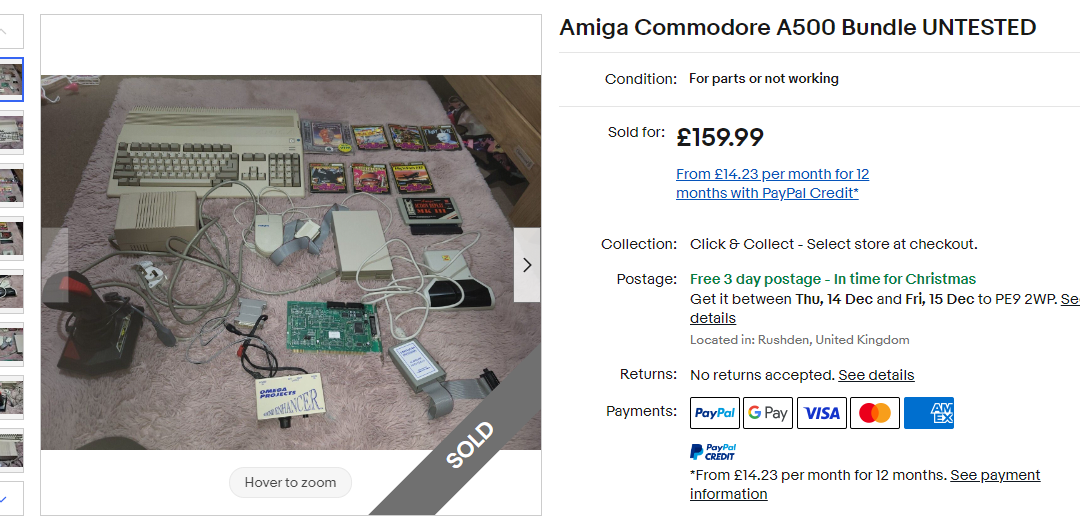Selling a retro computer on eBay can be both profitable and nostalgic. The key is to create a listing that not only attracts collectors and enthusiasts but also clearly conveys the value and condition of your vintage machine. Here’s how to create an effective eBay listing for your retro computer:
Create your LIsting
1. Understand Your Audience
- Know Your Buyers: Retro computers often attract collectors, hobbyists, and enthusiasts. Tailor your listing to appeal to their interests and needs.
- Highlight Rarity: If your computer is a rare model or has unique features, make sure to emphasize this.
2. Prepare Your Computer
- Clean and Restore: Gently clean the computer without damaging its vintage elements. Restore it to working condition if possible, but avoid modifications that aren’t true to its original design.
- Document the History: If you have the original manuals, receipts, or any backstory, include this information.
3. Take High-Quality Photos
- Show All Angles: Photograph the computer from multiple angles, showing the front, back, sides, and any ports or connectors.
- Detail Shots: Include close-ups of unique features, serial numbers, or brand markings.
- Current Condition: Capture any wear, tear, or damage to accurately represent its current state.
4. Craft a Compelling Description
- Be Specific: Include model number, manufacture date, specifications (like CPU, RAM), and original software/hardware features.
- Condition and Functionality: Clearly state the working condition. If it’s not functioning, specify this, as some buyers may seek parts or enjoy repairing.
- Unique Selling Points: What makes your retro computer special? Whether it’s a unique color, limited edition, or a famous previous owner, make it known.
5. Pricing Strategy
- Market Research: Look at completed listings for similar models to gauge a fair price. Be sure to check out eBay’s sold items filtering feature to see what your item has sold for in the past.
- Set a Competitive Price: Consider starting with a lower bid to attract more bidders or set a ‘Buy It Now’ price based on your research.
6. Shipping and Packaging
- Safe Packaging: Use ample protective materials to ensure safe transit, especially if the computer is fragile.
- Shipping Options: Offer various shipping options and be clear about shipping costs. International shipping can be attractive but more complex.
7. Interactive Listing
- Video Demonstration: If possible, include a video showing the computer turning on and functioning.
- Q&A Section: Be responsive to potential buyers’ questions in the listing’s Q&A section.
8. Promote Your Listing
- Social Media: Share your listing on social media platforms, especially in retro computing groups or forums.
- eBay Promotions: Consider using eBay’s promotional tools to increase the visibility of your listing.
9. Transaction and Follow-up
- Payment Methods: Be clear about acceptable payment methods. eBay offers various secure options.
- After-Sale Communication: Stay in touch with the buyer until the computer is received and they are satisfied.
10. Stay Informed
- eBay Policies: Familiarize yourself with eBay’s policies to ensure a smooth selling experience.
- Legal Compliance: Ensure you adhere to any legal requirements for selling electronic items in your area.
Beware of Scams
When selling items on eBay, it’s crucial to be vigilant against scams. Scammers often target sellers, especially those new to the platform. Here are three key strategies to help you avoid scams when selling on eBay.
1. Recognize Common Scam Tactics
The first step in avoiding scams is to recognize common tactics used by scammers. One typical scam involves the buyer claiming they never received the item, even after delivery confirmation. Scammers might also send fake emails that appear to be from eBay or PayPal, claiming that payment has been made and urging you to ship the item. Familiarize yourself with these and other common scam methods by regularly checking eBay’s own updates on fraudulent activities. Additionally, be wary of overpayments, where a buyer sends more money than the item’s price, and then requests a refund of the difference, often with a fraudulent payment method.
2. Implement Safe Selling Practices
To safeguard your transactions, follow eBay’s recommended safe selling practices. Always use eBay’s official communication channels to converse with buyers and avoid sharing personal contact information. When accepting payments, use secure methods approved by eBay, such as PayPal, which offers seller protection. Shipping items with tracking and insurance can also help protect you; this provides proof of delivery, which is useful if a buyer claims non-receipt. For higher-value items, consider requiring a signature upon delivery. Be cautious with buyers who rush you or pressure you into shipping items before the payment clears.
3. Stay Informed and Report Suspicious Activity
Staying informed is your best defense against scams. Regularly review eBay’s policies and guidelines to understand your rights and responsibilities as a seller. If you encounter a suspicious buyer or receive an odd request, report it to eBay immediately. eBay has systems in place to investigate and take action against fraudulent users. By reporting suspicious activities, you not only protect yourself but also help safeguard the broader eBay community. Remember, if an offer or inquiry seems too good to be true or raises red flags, it’s better to err on the side of caution.
eBay is a powerful platform for selling goods, it’s essential to stay alert to the possibility of scams. By recognizing common scam tactics, implementing safe selling practices, and staying informed, you can greatly reduce the risk of becoming a scam victim and ensure a more secure and successful selling experience on eBay.
Selling a retro computer on eBay requires a blend of passion for vintage technology and smart marketing tactics. By creating a detailed, honest, and appealing listing, you can attract the right buyers and ensure your cherished machine finds a new home with someone who appreciates its history and value.
If you’re still unsure or have any concerns, we here at Retro32 do buy Amiga hardware and software, for more information contact us.


